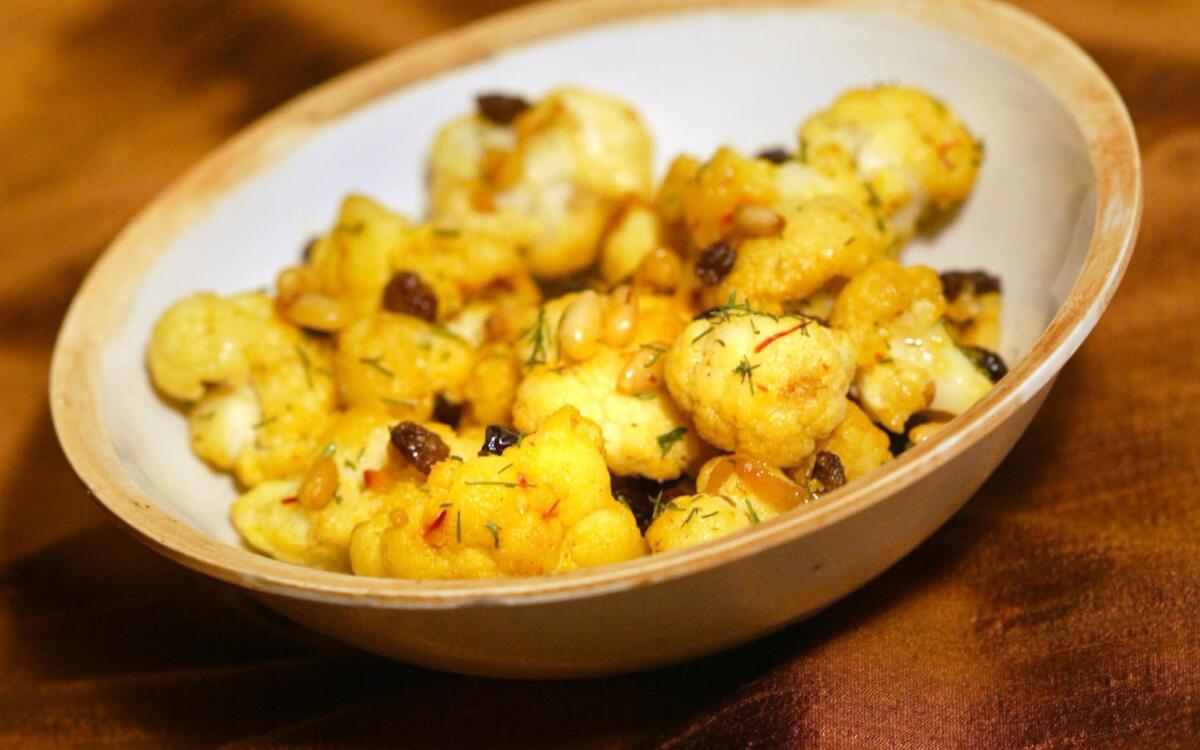Cauliflower with currants and pine nuts

If you’ve ever gazed up at the pine tree in your yard and wondered if you could harvest some fresh pine nuts from those cones, the answer is yes -- and good luck.
Pine nuts, also known by their Italian and Spanish names, pignoli and pinon (often spelled “pinyon”), come from specific varieties of pine trees, about 20 worldwide, that produce edible seeds. The individual seeds are encased in a hard shell inside the pine cone. After harvesting, the cones must first be heated, then left to dry before small, hard seeds can be shaken out of the cones. These seeds are cracked open to get to the pine nut.
This labor-intensive harvesting is the reason pine nuts are so expensive (the most expensive after macadamia nuts). It’s also the reason that, although the trees grow, literally, in our own backyards, the vast majority of pine nuts sold in this country come from China.
The finest pine nuts are generally thought to be Pinus pinea, a Mediterranean variety used in the cooking of that region for thousands of years. But they are prohibitively expensive here, at a wholesale price upwards of $30 a pound that prevents even specialty markets from stocking them.
Because they have no protective skin and are high in fat, the nuts turn ever-so-slightly rancid, and thus bitter, very quickly. Freezing helps preserve their flavor and keep the bitterness at bay (they can be stored in an airtight container in the freezer for up to nine months).
At one time, you could buy pine nuts in their shells in just about any grocery store -- they were packaged in cellophane, like sunflower seeds. In some markets in the Southwest and Nevada, you can still find them this way. But even if you do find them, prying the brittle shells off the little nuts is incredibly time-consuming.
So the idea is to find the freshest shelled pine nuts you can and use them right away.
Most cooks think pesto when they see pine nuts, or they think of toasting them and scattering them over salads or braised meats, or using them whole in pastas. The pine nuts contrast beautifully with the sweet-tart taste of dried currants or raisins; such a pairing is common in Sicily, where the nuts are sauteed with bitter greens such as chard or spooned over swordfish.
They add a touch of sweetness when mixed with ground beef in many Middle Eastern dishes, and they’re a diverting addition to chocolate confections and in nut brittles. Sprinkled over soft cheese or yogurt and drizzled honey, they make a distinctive dessert.
In Italy, pine nuts are used in a variety of confections. They’re churned into ice cream, added to ricotta cheesecake for torta di pasqua, an Easter specialty, and used to make many cookies.
For this story, we hoped to make a traditional Mediterranean pine nut cookie like those crispy, not-too-sweet biscuits often called Italian macaroons (because they are made with egg whites) and found in Italian bakeries.
We tested several variations on this theme, but the universal favorite was one made with almond paste and rolled in pine nuts. We ground some additional pine nuts and added the meal to the cookie dough so the flavor of the pine nuts would mingle with that of the almonds.
For the cauliflower recipe, we riffed on some of the ingredients for pasta alla palina, a Sicilian classic, with two other staple Sicilian ingredients, saffron and fennel. The result is a side dish with complex and contrasting sweet, buttery and nutty flavors. It’s a wonderful accompaniment to rich, flavorful meats such as lamb or pork -- perfect for fall.
For recipes that call for toasted pine nuts, cook the nuts on a baking sheet in a 350-degree oven for about 7 minutes or toast them on top of the stove in a nonstick skillet, tossing often to prevent burning, until the nuts are golden and fragrant.
To ensure the freshest pine nuts, shop for them at a busy store where you’ll be sure of a fast turnover, and make sure to smell and taste the nuts before using them. If you’re ready to refine your pine nut palate, you can buy a Spanish variety similar to Pinus pinea from A.G. Ferrari, a Bay Area Italian food importer, by going to the website at www.agferrari.com or calling (877) 878-2783 ($5.95 for a 4-ounce package).
Or maybe it’s simply time to get up there and shake that backyard tree.
Place the currants in a small bowl and add the white wine to cover. Let stand while preparing the remaining ingredients.
Lightly toast the saffron in a small skillet over low heat about 30 seconds. Remove from the heat and cool, then grind in a mortar. Add the water to the mortar and set aside to let the saffron steep.
Blanch the cauliflower in a large pot of boiling salted water until just tender and still crisp, about 3 minutes. Drain and cool under cold running water.
Heat 3 tablespoons of the oil in a large skillet. Add the shallot and saute over medium heat until fragrant and tender, about 1 minute. Add the garlic and saute until it is slightly tender, about 1 minute.
Stir in the drained cauliflower and add the salt and pepper. Saute over medium-high heat until the cauliflower is tender and slightly browned in spots, about 5 to 6 minutes.
Add the currants with the wine and simmer until wine is almost evaporated, about 2 to 5 minutes. Add the saffron with the water. Add the pine nuts and saute 1 minute.
Stir in the fennel fronds. Spoon into a serving dish. Drizzle with the remaining olive oil. Add salt and pepper to taste.
Get our Cooking newsletter.
Your roundup of inspiring recipes and kitchen tricks.
You may occasionally receive promotional content from the Los Angeles Times.















